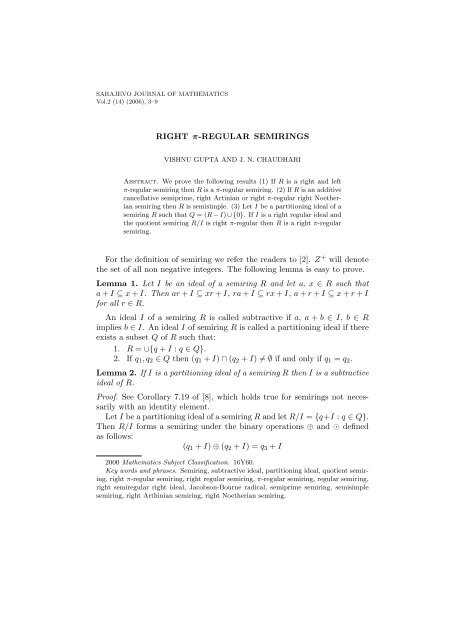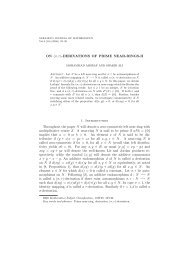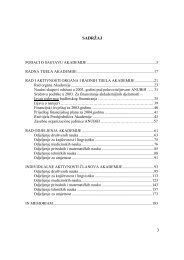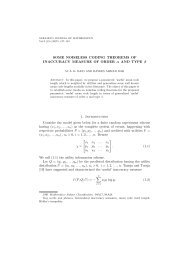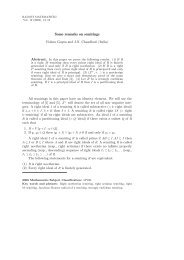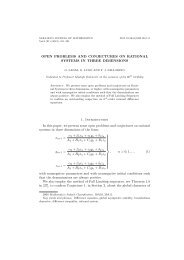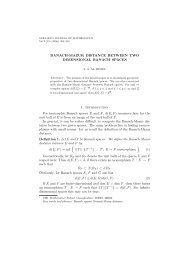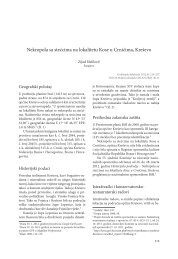RIGHT Ï-REGULAR SEMIRINGS For the definition of ... - anubih
RIGHT Ï-REGULAR SEMIRINGS For the definition of ... - anubih
RIGHT Ï-REGULAR SEMIRINGS For the definition of ... - anubih
You also want an ePaper? Increase the reach of your titles
YUMPU automatically turns print PDFs into web optimized ePapers that Google loves.
SARAJEVO JOURNAL OF MATHEMATICSVol.2 (14) (2006), 3–9<strong>RIGHT</strong> π-<strong>REGULAR</strong> <strong>SEMIRINGS</strong>VISHNU GUPTA AND J. N. CHAUDHARIAbstract. We prove <strong>the</strong> following results (1) If R is a right and leftπ-regular semiring <strong>the</strong>n R is a π-regular semiring. (2) If R is an additivecancellative semiprime, right Artinian or right π-regular right Noe<strong>the</strong>riansemiring <strong>the</strong>n R is semisimple. (3) Let I be a partitioning ideal <strong>of</strong> asemiring R such that Q = (R − I) ∪ {0}. If I is a right regular ideal and<strong>the</strong> quotient semiring R/I is right π-regular <strong>the</strong>n R is a right π-regularsemiring.<strong>For</strong> <strong>the</strong> <strong>definition</strong> <strong>of</strong> semiring we refer <strong>the</strong> readers to [2]. Z + will denote<strong>the</strong> set <strong>of</strong> all non negative integers. The following lemma is easy to prove.Lemma 1. Let I be an ideal <strong>of</strong> a semiring R and let a, x ∈ R such thata + I ⊆ x + I. Then ar + I ⊆ xr + I, ra + I ⊆ rx + I, a + r + I ⊆ x + r + Ifor all r ∈ R.An ideal I <strong>of</strong> a semiring R is called subtractive if a, a + b ∈ I, b ∈ Rimplies b ∈ I. An ideal I <strong>of</strong> semiring R is called a partitioning ideal if <strong>the</strong>reexists a subset Q <strong>of</strong> R such that:1. R = ∪{q + I : q ∈ Q}.2. If q 1 , q 2 ∈ Q <strong>the</strong>n (q 1 + I) ∩ (q 2 + I) ≠ ∅ if and only if q 1 = q 2 .Lemma 2. If I is a partitioning ideal <strong>of</strong> a semiring R <strong>the</strong>n I is a subtractiveideal <strong>of</strong> R.Pro<strong>of</strong>. See Corollary 7.19 <strong>of</strong> [8], which holds true for semirings not necessarilywith an identity element.Let I be a partitioning ideal <strong>of</strong> a semiring R and let R/I = {q+I : q ∈ Q}.Then R/I forms a semiring under <strong>the</strong> binary operations ⊕ and ⊙ definedas follows:(q 1 + I) ⊕ (q 2 + I) = q 3 + I2000 Ma<strong>the</strong>matics Subject Classification. 16Y60.Key words and phrases. Semiring, subtractive ideal, partitioning ideal, quotient semiring,right π-regular semiring, right regular semiring, π-regular semiring, regular semiring,right semiregular right ideal, Jacobson-Bourne radical, semiprime semiring, semisimplesemiring, right Arthinian semiring, right Noe<strong>the</strong>rian semiring.
4 VISHNU GUPTA AND J. N. CHAUDHARIwhere q 3 ∈ Q is <strong>the</strong> unique element such that q 1 + q 2 + I ⊆ q 3 + I.(q 1 + I) ⊙ (q 2 + I) = q 4 + Iwhere q 4 ∈ Q is <strong>the</strong> unique element such that q 1 q 2 + I ⊆ q 4 + I.This semiring R/I is called <strong>the</strong> quotient semiring <strong>of</strong> R by I. By <strong>definition</strong><strong>of</strong> partitioning ideal, <strong>the</strong>re exists a unique q ∈ Q such that 0 + I ⊆ q + 1.Then q + I is a zero element <strong>of</strong> R/I.An element a <strong>of</strong> a semiring R is called right π-regular (resp. π-regular) if<strong>the</strong>re exist x, y ∈ R and a positive integer n such that a n + a n+1 x = a n+1 y(resp. a n + a n xa n = a n ya n ). A semiring R is called right π-regular (resp.π-regular) if every element <strong>of</strong> R is right π-regular (resp. π-regular). If n = 1<strong>the</strong>n a is called a right regular (resp. regular) element <strong>of</strong> R. If every element<strong>of</strong> a semiring R is right regular (resp. regular) <strong>the</strong>n R is called a right regular(resp. regular) semiring.□{[ ]}a bExample 3. (i) Let R = : a, b, c ∈ ({0, 1}, max, min) . Then R is0 ca right π-regular, [ ] π-regular semiring but not right regular or regular. The0 1element is not right regular or regular.0 0(ii) Let R = {(a ij ) 2×2 : a ij ∈ ({0, 1}, max, min)}. Then R is a regularsemiring but not right, left regular.(iii) Let R = (Z + ∪ {−∞}, ⊕, ⊙) where a ⊕ b = max{a, b} and a ⊙ b = a + b.Then R is a commutative regular semiring with −∞ as a zero element and0 as an identity element. Let a ∈ R where a ≠ 0, −∞. Then <strong>the</strong>re does notexist any y ∈ R such that a = a ⊕ y ⊕ a.A right ideal I <strong>of</strong> a semiring R is called right semiregular if for everya 1 , a 2 ∈ I <strong>the</strong>re exist r 1 , r 2 ∈ I such that a 1 + r 1 + a 1 r 1 + a 2 r 2 = a 2 + r 2 +a 1 r 2 + a 2 r 1 . The sum <strong>of</strong> all right semiregular right ideals <strong>of</strong> a semiring Ris called <strong>the</strong> right Jacobson radical <strong>of</strong> R. The right Jacobson radical <strong>of</strong> Ris equal to <strong>the</strong> left Jacobson radical <strong>of</strong> R. It is called <strong>the</strong> Jacobson-Bourneradical <strong>of</strong> R. We denote it by J(R). It is a right semiregular right ideal <strong>of</strong> R.It is a two sided ideal <strong>of</strong> R. A semiring R is called semisimple if J(R) = 0(see [4]). Let R = (Z + , +, ·). Then by Theorem 9 <strong>of</strong> [4] and Theorem 4 <strong>of</strong> [9],<strong>the</strong> matrix semiring R n×n is semisimple. A semiring R is called semiprime ifit has no non-zero nilpotent ideals. Every semisimple semiring is semiprime([4], Theorem 7). A semiring R is called right Noe<strong>the</strong>rian (resp. rightArtinian) if <strong>the</strong>re exists no infinite properly ascending (resp. descending)sequence <strong>of</strong> right ideals I 1 ⊂ I 2 ⊂ I 3 ⊂ · · · (resp. I 1 ⊃ I 2 ⊃ I 3 ⊃ · · · ) <strong>of</strong> R.Theorem 4. If R is a right and left π-regular semiring <strong>the</strong>n R is a π-regularsemiring.
<strong>RIGHT</strong> π-<strong>REGULAR</strong> <strong>SEMIRINGS</strong> 5Pro<strong>of</strong>. Let a ∈ R. Then <strong>the</strong>re exist x, y, x ′ , y ′ ∈ R and positive integers m, nsuch thata m + a m+1 x = a m+1 y (1)a n + x ′ a n+1 = y ′ a n+1 . (2)Multiplying (1) by a from left, by y from right and using (1), we geta m + a m+1 x + a m+2 xy = a m+2 y 2 . (3)Now multiplying (3) by a from left, by x from right and <strong>the</strong>n adding a m , wegeta m + a m+1 x + a m+2 x 2 + a m+3 xyx = a m + a m+3 y 2 x. (4)By using (1), we can write (4) asa m + a m+3 z 1 = a m+1 z 2 where z 1 = y 2 x, z 2 = y + ax 2 + a 2 xyx. (5)Multiplying (5) by a from left and by z 2 from right, we getBy using (5), this can be written asa m+1 z 2 + a m+4 z 1 z 2 = a m+2 z 2 2. (6)a m + a m+2 w 1 = a m+2 w 2 where w 1 = az 1 + a 2 z 1 z 2 , w 2 = z 2 2. (7)Repeat <strong>the</strong> same process. After n − 1 steps, we geta m + a m+n u 1 = a m+n u 2 for some u 1 , u 2 ∈ R. (8)By using (2) and <strong>the</strong> similar argument as above, we getFrom (8) and (9), we geta n + v 1 a m+n = v 2 a m+n for some v 1 , v 2 ∈ R. (9)a m+n + a m v 1 a m+n + a m+n u 1 a n + a m+n u 1 v 1 a m+n = a m+n u 2 v 2 a m+n . (10)Adding a m+n u 1 v 1 a m+n in both sides <strong>of</strong> (10), we geta m+n + (a m + a m+n u 1 )v 1 a m+n + a m+n u 1 (a n + v 1 a m+n )By using (8) and (9), <strong>the</strong> equation (11) can be written as= a m+n (u 2 v 2 + u 1 v 1 )a m+n . (11)a m+n + a m+n (u 1 v 2 + u 2 v 1 )a m+n = a m+n (u 1 v 1 + u 2 v 2 )a m+n .Therefore R is a π-regular semiring.□A semiring R is called duo if every one sided ideal <strong>of</strong> R is a two sidedideal <strong>of</strong> R.Corollary 5. Let R be a duo semiring. Then R is a right π-regular semiringif and only if it is π-regular semiring.
6 VISHNU GUPTA AND J. N. CHAUDHARIPro<strong>of</strong>. Let a ∈ R. As in <strong>the</strong> above <strong>the</strong>orem, <strong>the</strong>re exist x, y ∈ R and apositive integer m such that a m + a m+2 x = a m+2 y. Let 〈a m+1 〉 1 be <strong>the</strong> leftideal <strong>of</strong> R generated by a m+1 . It is a two sided ideal <strong>of</strong> R. So a m+1 x, a m+1 y ∈〈a m+1 〉 1 . Hence a m+1 x = sa m+1 + ja m+1 , a m+1 y = ta m+1 + ka m+1 for somes, t ∈ R and j, k ∈ Z + . Hence a m + a(sa m+1 + ja m+1 ) = a(ta m+1 + ka m+1 ).So a m + ua m+1 = va m+1 for some u, v ∈ R. Therefore R is a left π-regularsemiring. So R is a π-regular semiring. Conversely, let a ∈ R. Then <strong>the</strong>reexist x, y ∈ R and a positive integer m such that a m + a m xa m = a m ya m .Let 〈a m 〉 r be <strong>the</strong> right ideal <strong>of</strong> R generated by a m . It is a two sided ideal <strong>of</strong>R. So xa m , ya m ∈ 〈a m 〉 r . Hence xa m = a m s + a m j, ya m = a m t + a m k forsome s, t ∈ R and j, k ∈ Z + . Now a m + a m (a m s + a m j) = a m (a m t + a m k).So a m + a 2m (s + j) = a 2m (t + k). If m > 1 <strong>the</strong>n a m + a m+1 w = a m+1 z forsome w, z ∈ R. If m = 1 <strong>the</strong>n a + a 2 (s + j) = a 2 (t + k). As in <strong>the</strong> above<strong>the</strong>orem, it is easy to see that a + a 2 u = a 2 v for some u, v ∈ R. ThereforeR is a right π-regular semiring.□Lemma 6. Let R be a right π-regular semiring and a ∈ J(R). Then a n +w =w for some w ∈ J(R) and positive integer n.Pro<strong>of</strong>. Let a ∈ J(R). Then <strong>the</strong>re exist x, y ∈ R and a positive integer nsuch thata n + a n+1 x = a n+1 y. (1)Since ax, ay ∈ J(R), <strong>the</strong>re exist s 1 , s 2 ∈ J(R) such that ax + s 1 + axs 1 +ays 2 = ay + s 2 + ays 1 + axs 2 . Now multiplying this by a n from left, we geta n+1 x + a n s 1 + a n+1 xs 1 + a n+1 ys 2 = a n+1 y + a n s 2 + a n+1 ys 1 + a n+1 xs 2 .Using (1), it can be written as a n+1 x + a n s 1 + a n+1 xs 1 + (a n + a n+1 x)s 2 =a n + a n+1 x + a n s 2 + (a n + a n+1 x)s 1 + a n+1 xs 2 . Now a n + w = w wherew = a n+1 x + a n s 1 + a n+1 xs 1 + a n s 2 + a n+1 xs 2 ∈ J(R).□Theorem 7. If R is an additive cancellative semiprime, right Artinian orright π-regular right Noe<strong>the</strong>rian semiring <strong>the</strong>n R is semisimple.Pro<strong>of</strong>. Let R be right Artinian. Easily, R is right π-regular. By Lemma 6,J(R) is a nil ideal. It is easy to see that J(R) is a nilpotent ideal <strong>of</strong> R. SoJ(R) = 0. Let R be right π-regular right Noe<strong>the</strong>rian semiring. Hence J(R)is a nil ideal. We can see that R has no non-zero nil ideal. So J(R) = 0. □The condition that R is an additive cancellative semiring is essential.Example 8. Let R = ({0, 1, 2, . . . , n}, max, min). Then R is a commutativesemiprime Noe<strong>the</strong>rian π-regular semiring with an identity element n. Itis not an additive cancellative semiring. Let I be an ideal <strong>of</strong> R and leta 1 , a 2 ∈ I. Then we can choose r 1 = r 2 = max{a 1 , a 2 } ∈ I such thata 1 + r 1 + a 1 r 1 + a 2 r 2 = a 2 + r 2 + a 1 r 2 + a 2 r 1 holds. Hence every ideal <strong>of</strong> Ris semiregular. Thus J(R) = R. So R is not semisimple.
<strong>RIGHT</strong> π-<strong>REGULAR</strong> <strong>SEMIRINGS</strong> 7Example 9. Let R = (Z + ∪ {∞}, max, min). Then R is a commutativesemiprime Artinian semiring with an identity element ∞. It is not an additivecancellative semiring. Every ideal <strong>of</strong> R is semiregular. So R is notsemisimple.Lemma 10. Let R be a semiring and a, x ∈ R. If a n +a n+1 x is right regularelement where n > 0 <strong>the</strong>n a is right π-regular element.Pro<strong>of</strong>. Let a n + a n+1 x be right regular element. Then a n + a n+1 x + (a n +a n+1 x) 2 w = (a n +a n+1 x) 2 z for some w, z ∈ R. Hence a n +a n+1 (x+a n−1 w+a n xw + xa n w + xa n+1 xw) = a n+1 (a n−1 + a n x + xa n + xa n+1 x)z. Thereforea is right π-regular.□Proposition 11. Every ideal <strong>of</strong> a right π-regular semiring is right π-regular.Pro<strong>of</strong>. Let I be an ideal <strong>of</strong> a right π-regular semiring R. Let a ∈ I. Then<strong>the</strong>re exist x, y ∈ R and a positive integer n such thata n + a n+1 x = a n+1 y. (1)Multiplying this equation by a from left, by x from right and <strong>the</strong>n addinga n in both sides, we geta n+1 y + a n+2 x 2 = a n + a n+1 x + a n+2 x 2 = a n + a n+2 yx. (2)Now multiplying (1) by a from left and by y from right and <strong>the</strong>n addinga n+2 x 2 in both sides, we get a n+2 x 2 + a n+1 y + a n+2 xy = a n+2 x 2 + a n+2 y 2 .Using (2) we have a n +a n+2 yx+a n+2 xy = a n+2 x 2 +a n+2 y 2 . So a n +a n+1 u 1 =a n+1 u 2 where u 1 = ayx + axy, u 2 = ax 2 + ay 2 ∈ I. Hence I is a right π-regular ideal.□Proposition 12. A semiring R is right π-regular if and only if R/I is rightπ-regular for every partitioning ideal I <strong>of</strong> R.Pro<strong>of</strong>. Define f : R → R/I by f(a) = q + I where q ∈ Q is <strong>the</strong> uniqueelement such that a + I ⊆ q + 1. Then f is an onto homomorphism. IfR is right π-regular semirng <strong>the</strong>n so is R/I. Conversely, since I = 0 is apartitioning ideal <strong>of</strong> R with Q = R, we see that R ∼ = R/0 is right π-regularsemiring.□Theorem 13. Let I be a partitioning ideal <strong>of</strong> a semiring R such that Q =(R − I) ∪ {0}. If I is a right regular ideal and <strong>the</strong> quotient semiring R/I isright π-regular <strong>the</strong>n R is a right π-regular semiring.Pro<strong>of</strong>. Let q ∈ R. If q ∈ I <strong>the</strong>n q is right π-regular. Suppose q /∈ I.Then q ∈ Q and q ≠ 0. Since R/I is right π-regular, <strong>the</strong>re exist q ′ + I,q ′′ +I ∈ R/I and a positive integer n such that (q+I) n ⊕(q+I) n+1 ⊙(q ′ +I) =(q + I) n+1 ⊙ (q ′′ + I) = q ∗ + I where q ∗ ∈ Q is <strong>the</strong> unique element such that
8 VISHNU GUPTA AND J. N. CHAUDHARI1. q n+1 q ′′ + I ⊆ q ∗ + I.2. q n + q n+1 q ′ + I ⊆ q ∗ + Iwhich follows by Lemma 1.(i) Suppose q n+1 q ′′ ∈ I. We have q n+1 q ′′ = q ∗ + x for some x ∈ I. Sinceby Lemma 2, I is a substractive ideal <strong>of</strong> R, q ∗ ∈ I. We have q n + q n+1 q ′ ∈q n + q n+1 q ′ + I ⊆ q ∗ + I ⊆ I. By Lemma 10, q is right π-regular. (ii) Ifq n+1 q ′′ /∈ I <strong>the</strong>n q n+1 q ′′ ∈ Q. So using (1) and <strong>the</strong> <strong>definition</strong> <strong>of</strong> partitioningideal, we get q n+1 q ′′ = q ∗ . Thus q n + q n+1 q ′ + I ⊆ q ∗ + I = q n+1 q ′′ + I.If q n + q n+1 q ′ ∈ Q <strong>the</strong>n q n + q n+1 q ′ = q n+1 q ′′ . Hence q is right π-regular.If q n + q n+1 q ′ /∈ Q <strong>the</strong>n q n + q n+1 q ′ ∈ I. Hence by Lemma 10, q is rightπ-regular. Now R is right π-regular.□The following example satisfies all <strong>the</strong> hypo<strong>the</strong>ses <strong>of</strong> <strong>the</strong> above <strong>the</strong>orem.Example 14. Let R = (Z + ∪ {∞}, max, min). Then R is a commutativesemiring with an identity element ∞. Let I = {0, 1, 2, 3, 4, 5}. Then I isa partitioning ideal <strong>of</strong> R where Q = {0, 6, 7, 8, . . .} ∪ {∞}. Hence Q =(R − I) ∪ {0}. Clearly I, R/I and R are regular.References[1] M. R. Adhikari, M. K. Sen and H. J. Weinert, On k-regular semirings, Bull. Cal.Math. Soc., 88 (1996), 141–144.[2] P. J. Allen, A fundamental <strong>the</strong>orem <strong>of</strong> homomorphism for semirings, Proc. Amer.Math. Soc., 21 (1969), 412–416.[3] P. B. Bhattacharya, S. K. Jain and S. R. Nagpaul, Basic Abstract Algebra, CambridgeUniversity Press, 1986.[4] S. Bourne, The Jacobson radical <strong>of</strong> a semiring, Prec. Nat. Acad. Sci., 37 (1951),163–170.[5] J. N. Chaudhari and V. Gupta, Weak primary decomposition <strong>the</strong>orem for right noe<strong>the</strong>riansemirings, Indian J. Pure and Appl. Math., 25 (1994),647–654.[6] F. Dischinger, π-reguliers, C.R. Acad. Sci. Paris, 283A (1976), 571–573.[7] S. Ghosh, A note on regularity in matrix semirings, Kyungpook Math J., 44 (2004),1–4.[8] J. S. Golan, The Theory <strong>of</strong> Semirings with Applications in Ma<strong>the</strong>matics and TheoreticalComputer Science, John Wiley and Sons, New York. 1992.[9] V. Gupta and J. N. Chaudhari, Some remarks on semirings, Rad. Mat., 12 (2003),13–18.[10] U. Hebisch and H. J. Weinert, Semirings-Algebraic Theory and Applications in ComputerScience, World Scientific Publishing Co. Pvt. Ltd., 1998.[11] Y. Hirano, Some studies <strong>of</strong> strongly π-regular rings, Math J. Okayama Univ., 20(1978), 141–149.[12] K. Iizuka, On <strong>the</strong> Jacobson radical <strong>of</strong> a semiring, Tohoku Math. J., 11 (1959), 409–421.[13] M. K. Sen and P. Mukhopadhyay, Von Neumann regularity in semirings, KyungpookMath. J., 35 (1995), 249–258.
<strong>RIGHT</strong> π-<strong>REGULAR</strong> <strong>SEMIRINGS</strong> 9(Received: July 6, 2004)Vishnu GuptaDepartment <strong>of</strong> Ma<strong>the</strong>maticsUniversity <strong>of</strong> DelhiDelhi 110 007, Indiavishnu gupta2k3@yahoo.co.inJ. N. ChaudhariDepartment <strong>of</strong> Ma<strong>the</strong>maticsM.J. CollegeJalgaon 425 002, India


